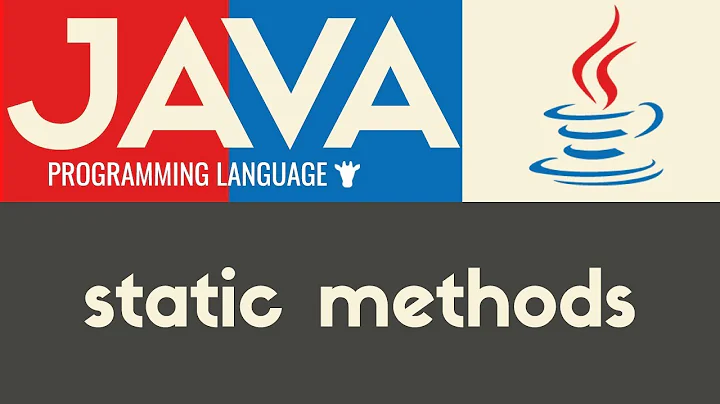Call static methods from regular ES6 class methods
Solution 1
Both ways are viable, but they do different things when it comes to inheritance with an overridden static method. Choose the one whose behavior you expect:
class Super {
static whoami() {
return "Super";
}
lognameA() {
console.log(Super.whoami());
}
lognameB() {
console.log(this.constructor.whoami());
}
}
class Sub extends Super {
static whoami() {
return "Sub";
}
}
new Sub().lognameA(); // Super
new Sub().lognameB(); // Sub
Referring to the static property via the class will be actually static and constantly give the same value. Using this.constructor instead will use dynamic dispatch and refer to the class of the current instance, where the static property might have the inherited value but could also be overridden.
This matches the behavior of Python, where you can choose to refer to static properties either via the class name or the instance self.
If you expect static properties not to be overridden (and always refer to the one of the current class), like in Java, use the explicit reference.
Solution 2
I stumbled over this thread searching for answer to similar case. Basically all answers are found, but it's still hard to extract the essentials from them.
Kinds of Access
Assume a class Foo probably derived from some other class(es) with probably more classes derived from it.
Then accessing
-
from static method/getter of Foo
- some probably overridden static method/getter:
this.method()this.property
- some probably overridden instance method/getter:
- impossible by design
- own non-overridden static method/getter:
Foo.method()Foo.property
- own non-overridden instance method/getter:
- impossible by design
- some probably overridden static method/getter:
-
from instance method/getter of Foo
- some probably overridden static method/getter:
this.constructor.method()this.constructor.property
- some probably overridden instance method/getter:
this.method()this.property
- own non-overridden static method/getter:
Foo.method()Foo.property
- own non-overridden instance method/getter:
-
not possible by intention unless using some workaround:
Foo.prototype.method.call( this )Object.getOwnPropertyDescriptor( Foo.prototype,"property" ).get.call(this);
-
not possible by intention unless using some workaround:
- some probably overridden static method/getter:
Keep in mind that using
thisisn't working this way when using arrow functions or invoking methods/getters explicitly bound to custom value.
Background
- When in context of an instance's method or getter
-
thisis referring to current instance. -
superis basically referring to same instance, but somewhat addressing methods and getters written in context of some class current one is extending (by using the prototype of Foo's prototype). - definition of instance's class used on creating it is available per
this.constructor.
-
- When in context of a static method or getter there is no "current instance" by intention and so
-
thisis available to refer to the definition of current class directly. -
superis not referring to some instance either, but to static methods and getters written in context of some class current one is extending.
-
Conclusion
Try this code:
class A {
constructor( input ) {
this.loose = this.constructor.getResult( input );
this.tight = A.getResult( input );
console.log( this.scaledProperty, Object.getOwnPropertyDescriptor( A.prototype, "scaledProperty" ).get.call( this ) );
}
get scaledProperty() {
return parseInt( this.loose ) * 100;
}
static getResult( input ) {
return input * this.scale;
}
static get scale() {
return 2;
}
}
class B extends A {
constructor( input ) {
super( input );
this.tight = B.getResult( input ) + " (of B)";
}
get scaledProperty() {
return parseInt( this.loose ) * 10000;
}
static get scale() {
return 4;
}
}
class C extends B {
constructor( input ) {
super( input );
}
static get scale() {
return 5;
}
}
class D extends C {
constructor( input ) {
super( input );
}
static getResult( input ) {
return super.getResult( input ) + " (overridden)";
}
static get scale() {
return 10;
}
}
let instanceA = new A( 4 );
console.log( "A.loose", instanceA.loose );
console.log( "A.tight", instanceA.tight );
let instanceB = new B( 4 );
console.log( "B.loose", instanceB.loose );
console.log( "B.tight", instanceB.tight );
let instanceC = new C( 4 );
console.log( "C.loose", instanceC.loose );
console.log( "C.tight", instanceC.tight );
let instanceD = new D( 4 );
console.log( "D.loose", instanceD.loose );
console.log( "D.tight", instanceD.tight );Solution 3
If you are planning on doing any kind of inheritance, then I would recommend this.constructor. This simple example should illustrate why:
class ConstructorSuper {
constructor(n){
this.n = n;
}
static print(n){
console.log(this.name, n);
}
callPrint(){
this.constructor.print(this.n);
}
}
class ConstructorSub extends ConstructorSuper {
constructor(n){
this.n = n;
}
}
let test1 = new ConstructorSuper("Hello ConstructorSuper!");
console.log(test1.callPrint());
let test2 = new ConstructorSub("Hello ConstructorSub!");
console.log(test2.callPrint());
-
test1.callPrint()will logConstructorSuper Hello ConstructorSuper!to the console -
test2.callPrint()will logConstructorSub Hello ConstructorSub!to the console
The named class will not deal with inheritance nicely unless you explicitly redefine every function that makes a reference to the named Class. Here is an example:
class NamedSuper {
constructor(n){
this.n = n;
}
static print(n){
console.log(NamedSuper.name, n);
}
callPrint(){
NamedSuper.print(this.n);
}
}
class NamedSub extends NamedSuper {
constructor(n){
this.n = n;
}
}
let test3 = new NamedSuper("Hello NamedSuper!");
console.log(test3.callPrint());
let test4 = new NamedSub("Hello NamedSub!");
console.log(test4.callPrint());
-
test3.callPrint()will logNamedSuper Hello NamedSuper!to the console -
test4.callPrint()will logNamedSuper Hello NamedSub!to the console
See all the above running in Babel REPL.
You can see from this that test4 still thinks it's in the super class; in this example it might not seem like a huge deal, but if you are trying to reference member functions that have been overridden or new member variables, you'll find yourself in trouble.
Related videos on Youtube
simonzack
Programmer, Reverse Engineer. GitHub: https://github.com/simonzack BlogSpot: http://simonscodes.blogspot.com/
Updated on June 11, 2020Comments
-
simonzack almost 4 years
What's the standard way to call static methods? I can think of using
constructoror using the name of the class itself, I don't like the latter since it doesn't feel necessary. Is the former the recommended way, or is there something else?Here's a (contrived) example:
class SomeObject { constructor(n){ this.n = n; } static print(n){ console.log(n); } printN(){ this.constructor.print(this.n); } }-
dfsq about 9 years
SomeObject.printfeels natural. Butthis.ninside makes no sense since there is no instance, if we are talking about static methods. -
simonzack about 9 years@dfsq
printNis not static though. -
dfsq about 9 yearsYou are right, confused names.
-
Thoran over 8 yearsI am curious why this question does not have so many upvotes! Isn't this a common practice for creating utility functions?
-
-
Bergi about 9 yearsBut static function are no overridden member methods? Usually you are trying not to reference any overridden stuff statically.
-
 Andrew Odri about 9 years@Bergi I'm not sure I understand what you are pointing out, but one specific case I have come across would is with MVC model hydration patterns. Sub classes extending a model may want to implement a static hydrate function. However, when these are hard-coded in, base model instances are only ever returned. This is a pretty specific example, but many patterns that rely on having a static collection of registered instances would be effected by this. One big disclaimer is that we are trying to simulate classical inheritance here, rather than prototypal inheritance... And that is not popular :P
Andrew Odri about 9 years@Bergi I'm not sure I understand what you are pointing out, but one specific case I have come across would is with MVC model hydration patterns. Sub classes extending a model may want to implement a static hydrate function. However, when these are hard-coded in, base model instances are only ever returned. This is a pretty specific example, but many patterns that rely on having a static collection of registered instances would be effected by this. One big disclaimer is that we are trying to simulate classical inheritance here, rather than prototypal inheritance... And that is not popular :P -
Bergi about 9 yearsYeah, as I concluded now in my own answer this is not even solved consistently in "classical" inheritance - sometimes you might want overrides, sometimes not. The first part of my comment pointed at static class functions, which I did not consider to be "members". Better ignore it :-)
-
Chris almost 8 yearscan you explain the constructor property vs class method definition?
-
Bergi almost 8 years@Chris: Every class is a constructor function (just like you know it from ES5 without
classsyntax), there is no difference in the definition of the method. It's just a matter of how you look it up, via the inheritedconstructorproperty or directly by its name. -
 Roy Tinker over 6 years
Roy Tinker over 6 yearsOwn non-overridden instance method/getter / not possible by intention unless using some workaround--- That's a real pity. In my opinion, this is a shortcoming of ES6+. Maybe it should be updated to allow simply referring tomethod-- i.e.method.call(this). Better thanFoo.prototype.method. Babel/etc. could implement using an NFE (named function expression). -
Thomas Urban over 6 years
method.call( this )is a probable solution except for themethodisn't bound to the desired base "class" then and thus fails to be a non-overriden instance method/getter. It's always possible to work with class-independent methods that way. Nonetheless I don't think current design is that bad. In context of objects of class derived from your base class Foo there may be good reasons to override an instance method. That overriden method may have good reasons to invoke itssuperimplementation or not. Either case is eligible and should be obeyed. Otherwise it would end in bad OOP design. -
 Roy Tinker over 6 yearsDespite the OOP sugar, ES methods are still functions, and people will want to use and reference them as such. My problem with ES class syntax is that it provides no direct reference to the currently executing method -- something that used to be easy via
Roy Tinker over 6 yearsDespite the OOP sugar, ES methods are still functions, and people will want to use and reference them as such. My problem with ES class syntax is that it provides no direct reference to the currently executing method -- something that used to be easy viaarguments.calleeor an NFE. -
Thomas Urban over 6 yearsSounds like bad practice or at least bad software design anyway. I'd consider both points of view contrary to each other, as I don't see eligible reason in context of OOP paradigm that involves accessing currently invoked method by reference (which is not just its context as is available via
this). It sound like trying to mix benefits of pointer arithmetics of bare C with higher-level C#. Just out of curiosity: what would you usearguments.calleefor in cleanly designed OOP code? -
 Roy Tinker over 6 yearsI'm working in a large project built with Dojo's class system, which allows calling the superclass(es) implementation(s) of the current method via
Roy Tinker over 6 yearsI'm working in a large project built with Dojo's class system, which allows calling the superclass(es) implementation(s) of the current method viathis.inherited(currentFn, arguments);-- wherecurrentFnis a reference to the currently executing function. Not being able to reference the currently executing function directly is making it a little hairy in TypeScript, which takes its class syntax from ES6. -
Thomas Urban over 6 yearsI see! This is mostly due to heterogenic setups demanding to mix the old world with the new one. I was using similar approach in a project myself and the reference on current method is required indeed for traversing the prototype chain to prevent infinite regressions when looking for next overloaded version. However this is past in a purely ES6 project. So, for now I stick with old code in old projects or try deriving from old-style classes and start using ES6 inheritance handling in such derived classes, only, though I don't know the specifics of Dojo classes, thus can't tell about your case.
-
 ricanontherun almost 6 yearsAnother example is PHP's Late Static Bindings. Not only does this.constructor respect inheritance, but also helps you avoid having to update code if you change the class name.
ricanontherun almost 6 yearsAnother example is PHP's Late Static Bindings. Not only does this.constructor respect inheritance, but also helps you avoid having to update code if you change the class name. -
Bergi almost 6 years@ricanontherun Having to update the code when you change variable names is not an argument against using names. Also refactoring tools can do it automatically anyway.
-
 ayZagen about 5 yearsHow to implement this in typescript ? It gives the error
ayZagen about 5 yearsHow to implement this in typescript ? It gives the errorProperty 'staticProperty' does not exist on type 'Function' -
Bergi about 5 years@ayZagen I dunno, I guess you should ask a new question about how to do the TypeScript typing for this, and post the non-working code there.





